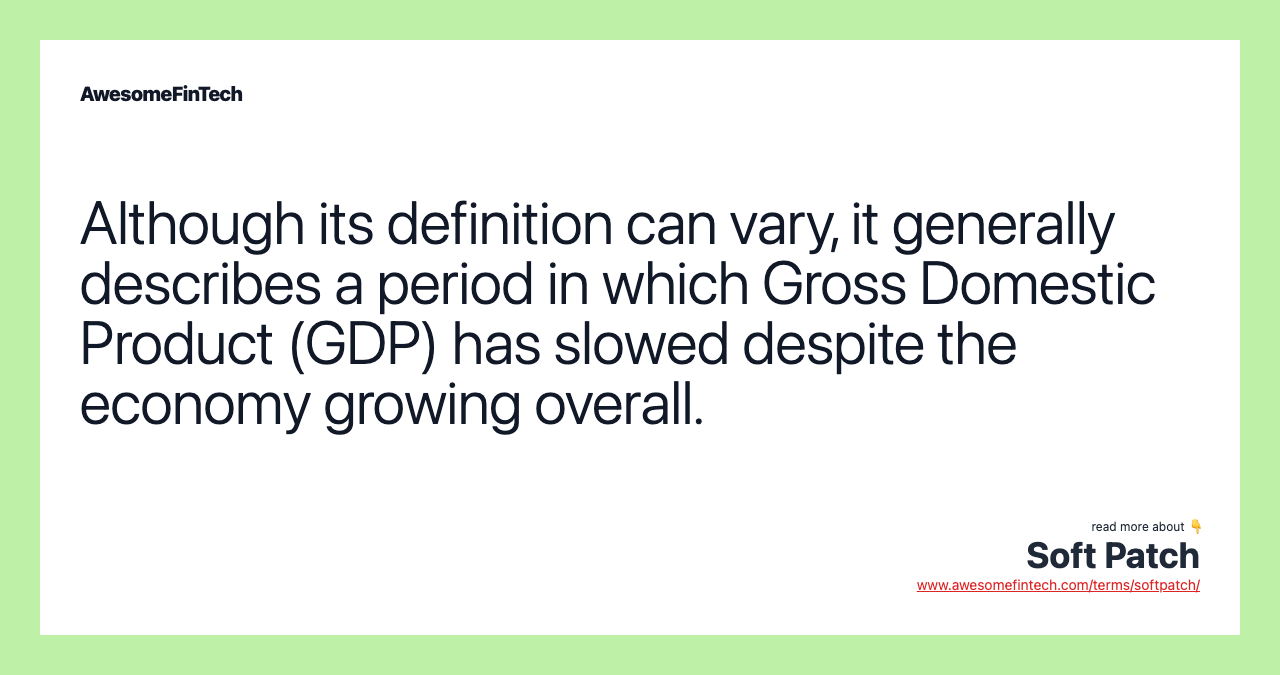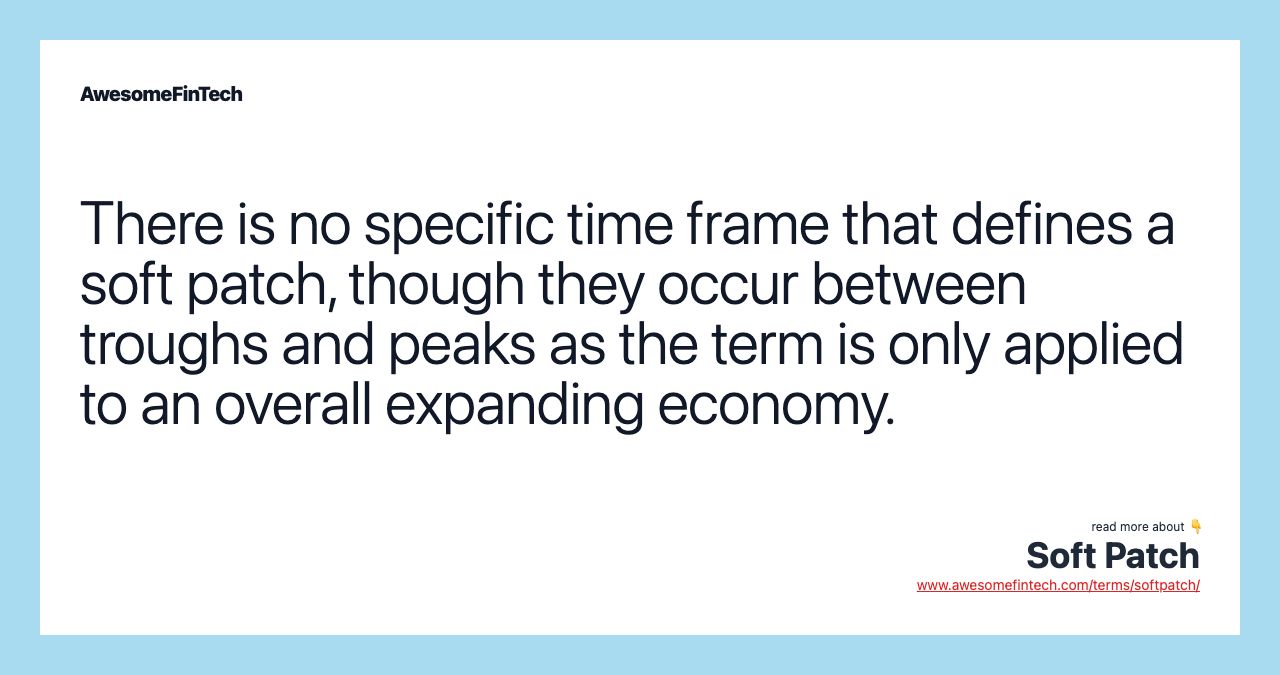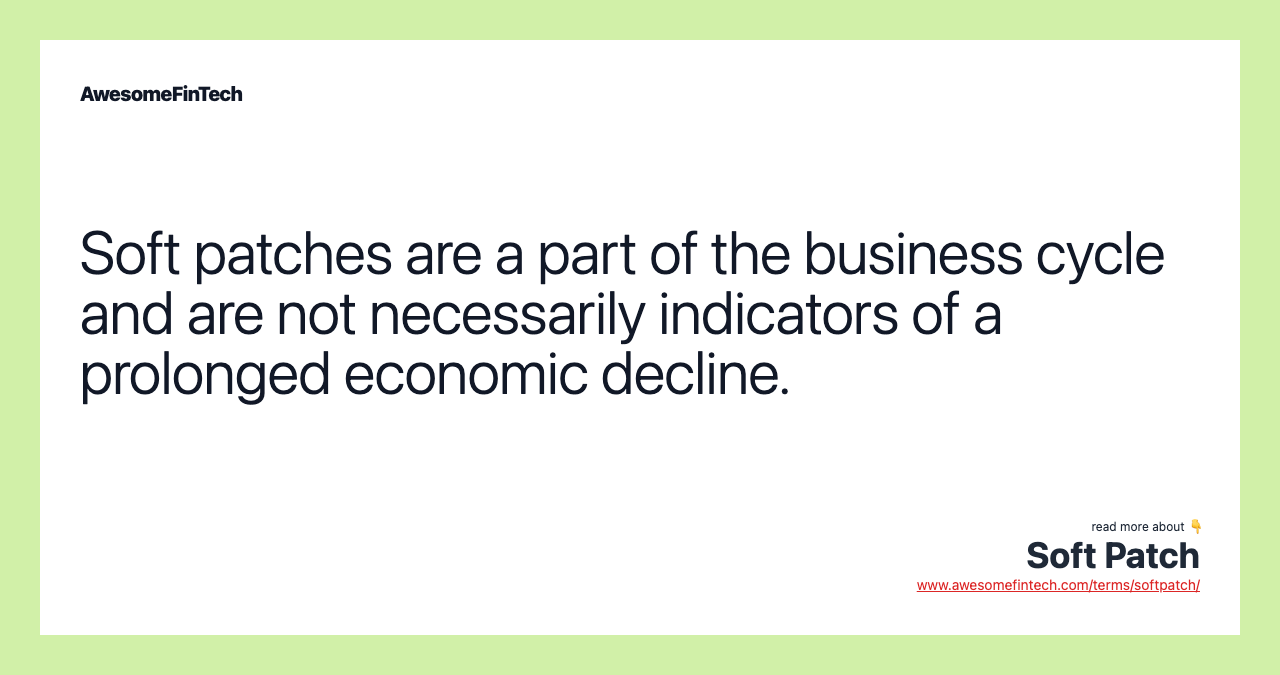Soft Patch
The term "soft patch" refers to a period in which the economy has slowed down amidst a larger trend of economic growth. Although any particular soft patch is unlikely to reliably predict a turning point in the overall business cycle, longitudinal data shows that all 11 business cycle expansions that occurred during this timeframe (1950 through 2012) were preceded by a soft patch. In addition to the term soft patch, other terms, such as soft sell and soft landing, are also used to describe different interpretations of GDP growth. If an economy continued its decline in GDP, then that would not indicate a soft patch but rather a market reversal towards a recession and possibly a depression. Alan Greenspan popularized the term during his tenure as chair of the Federal Reserve between 1987 and 2006. A two-quarter soft patch occurs when the gross domestic product (GDP) growth in the two most recent quarters is less than the growth during the preceding quarter.

More in Economy
What Is a Soft Patch?
The term "soft patch" refers to a period in which the economy has slowed down amidst a larger trend of economic growth. The term is often used informally in the financial media and in statements issued by the U.S. Federal Reserve when describing periods of economic weakness.





Understanding a Soft Patch
The term "soft patch" is often used to describe a decline in the real gross domestic product (real GDP) that lasts for two or three quarters at a time. A two-quarter soft patch occurs when the gross domestic product (GDP) growth in the two most recent quarters is less than the growth during the preceding quarter. Similarly, a three-quarter soft patch occurs when the three most recent quarters reflect lower growth than the quarter immediately prior.
The traditional definition of a recession is also characterized by a decline in GDP for two successive quarters. A soft patch is defined with a little less rigidity than a recession and occurs between troughs and peaks as it is only used during periods of overall expansion. If an economy continued its decline in GDP, then that would not indicate a soft patch but rather a market reversal towards a recession and possibly a depression.
Alan Greenspan popularized the term during his tenure as chair of the Federal Reserve between 1987 and 2006. However, you can find mentions of the term in Federal Reserve publications from as far back as the 1940s.
Despite its common usage, there is no precise and generally accepted definition of what a soft patch really means. For instance, the term is also used to describe circumstances in which GDP has slowed in response to a short-term rise in commodity prices.
In addition to the term soft patch, other terms, such as soft sell and soft landing, are also used to describe different interpretations of GDP growth.
Market participants primarily use the term to indicate a general slowdown of the economy that could potentially impact investors, businesses, and employment.
Soft Patches in the Economy
The National Bureau of Economic Research (NBER) has published data indicating that between 1950 and 2012, the U.S. economy experienced 69 instances in which a soft patch lasted more than two quarters; and 52 instances in which it lasted more than three quarters. This data suggests that the phenomenon is indeed quite common.
At the same time, it is difficult to tell how significant an event each soft patch is. Although any particular soft patch is unlikely to reliably predict a turning point in the overall business cycle, longitudinal data shows that all 11 business cycle expansions that occurred during this timeframe (1950 through 2012) were preceded by a soft patch.
Through this analysis, one can confirm that soft patches are a part of the business cycle and are not necessarily harbingers of a prolonged economic decline.
With this in mind, it is easy to understand why soft patches remain a topic of interest to financial media and policymakers alike. All market participants are understandably concerned with where we stand in relation to the overall business cycle since changes in that cycle will inevitably trigger reallocations of capital throughout different types of assets, thereby impacting investors’ portfolios.
For instance, MarketWatch published an article in April 2019 questioning whether first-quarter GDP growth pointed to a soft patch in the economy, which they suggested may be attributable to the 35-day government shutdown that affected almost a million federal employees earlier in the year. Though first-quarter results have traditionally been impacted by factors that stunt growth, even after seasonal adjustments from the holiday period are taken into consideration.
Related terms:
Who Is Alan Greenspan? How long was Greenspan Fed chair?
Alan Greenspan was the 13th chair of the Federal Reserve, appointed to an unprecedented five consecutive terms between mid-1987 and early 2006. read more
Business Cycle : How Is It Measured?
The business cycle depicts the increase and decrease in production output of goods and services in an economy. read more
Economics : Overview, Types, & Indicators
Economics is a branch of social science focused on the production, distribution, and consumption of goods and services. read more
Federal Reserve System (FRS)
The Federal Reserve System is the central bank of the United States and provides the nation with a safe, flexible, and stable financial system. read more
Gross Domestic Product (GDP)
Gross domestic product (GDP) is the monetary value of all finished goods and services made within a country during a specific period. read more
Goldilocks Economy
A Goldilocks economy has steady economic growth, preventing a recession, but not so much growth that inflation rises by too much. read more
Inflation
Inflation is a decrease in the purchasing power of money, reflected in a general increase in the prices of goods and services in an economy. read more
Macro Environment
"Macro-environment" refers to the overall condition of the economy, as opposed to the well-being of a particular sector or region. read more
National Bureau of Economic Research (NBER)
The National Bureau of Economic Research is a private, non-profit, non-partisan research organization to promote a greater understanding of the economy. read more
Quarter (Q1, Q2, Q3, Q4)
A quarter is a three-month period on a company's financial calendar that acts as a basis for the reporting of earnings and the paying of dividends. read more